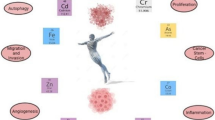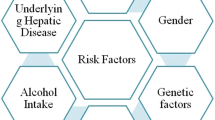Abstract
Cadmium, a common metal, is an environmental contaminant that is hepatotoxic and immunotoxic. Cadmium exposure may affect hepatitis B immunity. The purpose of this study was to assess the association between cadmium exposure and hepatitis B serology in the US population and to develop a model to predict susceptibility of hepatitis B. The study included 50,588 individuals in the National Health and Nutrition Examination Survey (NHANES) from 2007 to 2016. Univariate and multivariate logistic regression and dose–response curves were used to evaluate the relationship between cadmium exposure and hepatitis B serology. Through multivariate logistic regression results, a predictive model was established, and relevant indicators were used to verify the clinical value of the model and evaluate prognostic value of serum cadmium concentration in patients with hepatitis B. We selected 5989 (≥ 6 years old) participants. Univariate logistic regression analysis showed that gender (aOR = 0.7192, 95% CI = 0.6492–0.7968), age (aOR = 1.030, 95% CI = 1.026–1.033), race (aOR = 0.8974, 95% CI = 0.8591–0.9374), poverty ratio (aOR = 1.042, 95% CI = 0.9872–1.101), body mass index (BMI) (aOR = 1.052, 95% CI = 1.044–1.061), hypertension (aOR = 2.017, 95% CI = 1.763–2.306), diabetes (aOR = 2.673, 95% CI = 2.119–3.370), vigorous recreational activities (aOR = 0.6369, 95% CI = 0.5725–0.7085), moderate recreational activity (aOR = 0.7681, 95% CI = 0.6935–0.8574) and cadmium (aOR = 1.295, 95% CI = 1.168–1.436) were closely related to hepatitis B virus (HBV) susceptibility. After adjusting for these confounding factors, multivariate logistic regression analysis showed that the odds ratio of HBV susceptibility was positively correlated with the level of cadmium in serum. The effectiveness of the model was then evaluated by establishing a nomogram, and by calibration curves, ROC curves, and clinical decision curves. Our study shows that cadmium exposure is positively associated with HBV susceptibility risk in the US population, and the constructed model has clinical significance.





Similar content being viewed by others
Data availability
The data that support the findings of this study are available from the corresponding author, Jie Wang, upon reasonable request.
References
Abt E, Robin LP (2020) Perspective on cadmium and lead in cocoa and chocolate. J Agric Food Chem 68:13008–13015
Alkharashi NAO, Periasamy VS, Athinarayanan J, Alshatwi AA (2017) Cadmium triggers mitochondrial oxidative stress in human peripheral blood lymphocytes and monocytes: analysis using in vitro and system toxicology approaches. J Trace Elem Med Biol 42:117–128
Gu J, Wang Y, Liu Y, Shi M, Yin L, Hou Y, Zhou Y, Chu Wong CK, Chen D, Guo Z, Shi H (2019) Inhibition of autophagy alleviates cadmium-induced mouse spleen and human b cells apoptosis. Toxicol Sci 170:109–122
Hanson ML, Brundage KM, Schafer R, Tou JC, Barnett JB (2010) Prenatal cadmium exposure dysregulates sonic hedgehog and Wnt/beta-catenin signaling in the thymus resulting in altered thymocyte development. Toxicol Appl Pharmacol 242:136–145
Helms EJ, Berry MW, Chaw RC, DuFort CC, Sun D, Onate MK, Oon C, Bhattacharyya S, Sanford-Crane H, Horton W, Finan JM, Sattler A, Makar R, Dawson DW, Xia Z, Hingorani SR, Sherman MH (2022) Mesenchymal lineage heterogeneity underlies nonredundant functions of pancreatic cancer-associated fibroblasts. Cancer Discov 12:484–501
Jeng WJ, Papatheodoridis GV, Lok ASF (2023) Hepatitis B. Lancet 401(10381):1039–1052
Jin Y, Liu L, Zhang S, He R, Wu Y, Chen G, Fu Z (2016) Cadmium exposure to murine macrophages decreases their inflammatory responses and increases their oxidative stress. Chemosphere 144:168–175
Liu C, Li HJ, Duan WX, Duan Y, Yu Q, Zhang T, Sun YP, Li YY, Liu YS, Xu SC (2023) MCU upregulation overactivates mitophagy by promoting vdac1 dimerization and ubiquitination in the hepatotoxicity of cadmium. Adv Sci (weinh) 10:e2203869
Ma Y, Su Q, Yue C, Zou H, Zhu J, Zhao H, Song R, Liu Z (2022) The effect of oxidative stress-induced autophagy by cadmium exposure in kidney, liver, and bone damage, and neurotoxicity. Int J Mol Sci 23(21):13491
McElroy JA, Shafer MM, Trentham-Dietz A, Hampton JM, Newcomb PA (2006) Cadmium exposure and breast cancer risk. J Natl Cancer Inst 98:869–873
Ninkov M, Popov Aleksandrov A, Demenesku J, Mirkov I, Mileusnic D, Petrovic A, Grigorov I, Zolotarevski L, Tolinacki M, Kataranovski D, Brceski I, Kataranovski M (2015) Toxicity of oral cadmium intake: impact on gut immunity. Toxicol Lett 237:89–99
Orr SE, Bridges CC (2017) Chronic kidney disease and exposure to nephrotoxic metals. Int J Mol Sci 18(5):1039
Pattyn J, Hendrickx G, Vorsters A, Van Damme P (2021) Hepatitis B vaccines. J Infect Dis 224:S343–S351
Renu K, Chakraborty R, Myakala H, Koti R, Famurewa AC, Madhyastha H, Vellingiri B, George A, ValsalaGopalakrishnan A (2021) Molecular mechanism of heavy metals (Lead, Chromium, Arsenic, Mercury, Nickel and Cadmium) - induced hepatotoxicity - A review. Chemosphere 271:129735
Sell S, Ilic Z (1994) Dietary cadmium may enhance the progression of hepatocellular tumors in hepatitis B transgenic mice. Carcinogenesis 15:2057–60
Satarug S, Garrett SH, Sens MA, Sens DA (2010) Cadmium, environmental exposure, and health outcomes. Environ Health Perspect 118:182–190
Schilsky ML (2013) Hepatitis B “360.” Transplant Proc 45:982–985
Sun Y, Zhou Q, Zheng J (2019) Nephrotoxic metals of cadmium, lead, mercury and arsenic and the odds of kidney stones in adults: An exposure-response analysis of NHANES 2007–2016. Environ Int 132:105115
Trepo C, Chan HL, Lok A (2014) Hepatitis B virus infection. Lancet 384:2053–2063
Van Damme P, Van Herck K (2007) A review of the long-term protection after hepatitis A and B vaccination. Travel Med Infect Dis 5:79–84
Waalkes MP (2003) Cadmium carcinogenesis. Mutat Res 533:107–120
Wang Z, Sun Y, Yao W, Ba Q, Wang H (2021) Effects of cadmium exposure on the immune system and immunoregulation. Front Immunol 12:695484
Yeo YH, Le MH, Chang ET, Henry L, Nguyen MH (2019) Prevalence of undetectable vaccine-induced immunity against Hepatitis B virus in US adults at high risk for infection. Hepatology 69:1385–1397
Zhang H, Yan J, Niu J, Wang H, Li X (2022) Association between lead and cadmium co-exposure and systemic immune inflammation in residents living near a mining and smelting area in NW China. Chemosphere 287:132190
Zoulim F, Levrero M, Testoni B (2018) Hepatitis B. Nat Rev Gastroenterol Hepatol. https://doi.org/10.1038/s41575-018-0060-3
Funding
This work was supported by the National Nature Science Foundation of China (81973625).
Author information
Authors and Affiliations
Contributions
(I) Conception and design: Jiahao Lu, Zhangpeng Shi and Jie Wang.
(II) Administrative support: Huanlong Qin and Jie Wang.
(III) Collection and assembly of data: Dongxiao Shen, Yiting Zhou, Yuejiao Feng and Donghao Tang.
(IV) Data analysis and interpretation: Jiahao Lu, Zhangpeng Shi and Huiqing Hu.
(V) Manuscript writing: All authors.
(VI) Final approval of manuscript: All authors.
Corresponding author
Ethics declarations
Ethical Approval
The authors are accountable for all aspects of the work in ensuring that questions related to the accuracy or integrity of any part of the work are appropriately investigated and resolved. The study was conducted in accordance with the Declaration of Helsinki (as revised in 2013). This study used previously collected deidentified data, which were deemed exempt from review by the Ethics Committee of Shanghai Putuo District Central Hospital.
Consent to participate
Consent was given by all the authors.
Consent to publish
Consent was given by all the authors.
Competing interests
The author reports no conflicts of interest in this work.
Additional information
Responsible Editor: Lotfi Aleya
Publisher's note
Springer Nature remains neutral with regard to jurisdictional claims in published maps and institutional affiliations.
Supplementary Information
Below is the link to the electronic supplementary material.
Rights and permissions
Springer Nature or its licensor (e.g. a society or other partner) holds exclusive rights to this article under a publishing agreement with the author(s) or other rightsholder(s); author self-archiving of the accepted manuscript version of this article is solely governed by the terms of such publishing agreement and applicable law.
About this article
Cite this article
Lu, J., Shi, Z., Hu, H. et al. The relationship between cadmium exposure and hepatitis B susceptibility and the establishment of its prediction model. Environ Sci Pollut Res 30, 95801–95809 (2023). https://doi.org/10.1007/s11356-023-29267-1
Received:
Accepted:
Published:
Issue Date:
DOI: https://doi.org/10.1007/s11356-023-29267-1




